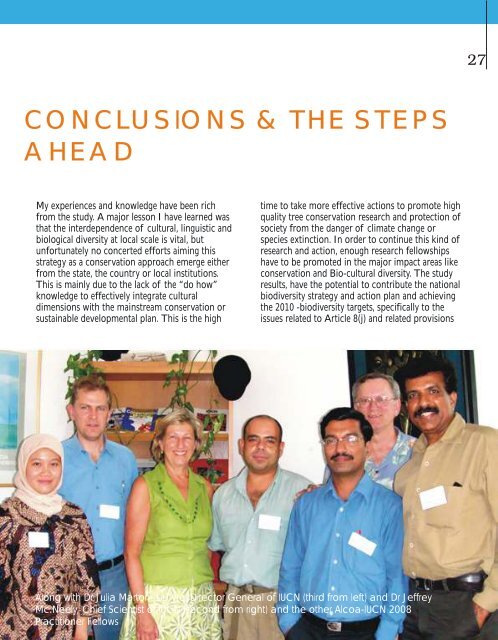Images - IUCN
Images - IUCN
Images - IUCN
You also want an ePaper? Increase the reach of your titles
YUMPU automatically turns print PDFs into web optimized ePapers that Google loves.
CONCLUSIONS & THE STEPS<br />
AHEAD<br />
My experiences and knowledge have been rich<br />
from the study. A major lesson I have learned was<br />
that the interdependence of cultural, linguistic and<br />
biological diversity at local scale is vital, but<br />
unfortunately no concerted efforts aiming this<br />
strategy as a conservation approach emerge either<br />
from the state, the country or local institutions.<br />
This is mainly due to the lack of the “do how”<br />
knowledge to effectively integrate cultural<br />
dimensions with the mainstream conservation or<br />
sustainable developmental plan. This is the high<br />
time to take more effective actions to promote high<br />
quality tree conservation research and protection of<br />
society from the danger of climate change or<br />
species extinction. In order to continue this kind of<br />
research and action, enough research fellowships<br />
have to be promoted in the major impact areas like<br />
conservation and Bio-cultural diversity. The study<br />
results, have the potential to contribute the national<br />
biodiversity strategy and action plan and achieving<br />
the 2010 -biodiversity targets, specifically to the<br />
issues related to Article 8(j) and related provisions<br />
Along with Dr Julia Marton- Lef’vre, Director General of <strong>IUCN</strong> (third from left) and Dr Jeffrey<br />
Mc.Neely, Chief Scientist of <strong>IUCN</strong> (second from right) and the other Alcoa-<strong>IUCN</strong> 2008<br />
Practitioner Fellows<br />
27

















